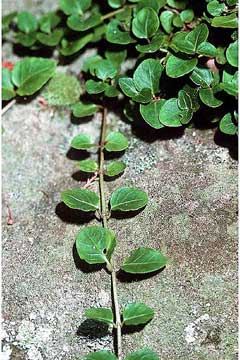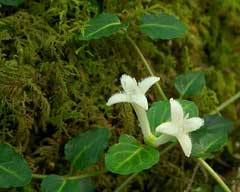 |
|
Robert H. Mohlenbrock @ USDA-NRCS PLANTS Database / USDA SCS. 1991. Southern wetland flora: Field office guide to plant species. South National Technical Center, Fort Worth, TX |
 |
| http://www.flickr.com/people/7147684@N03 |
Translate this page:
Summary
Bloom Color: White. Main Bloom Time: Early summer. Form: Spreading or horizontal.
Physical Characteristics

 Mitchella repens is an evergreen Shrub growing to 0.1 m (0ft 4in) by 0.5 m (1ft 8in) at a slow rate.
Mitchella repens is an evergreen Shrub growing to 0.1 m (0ft 4in) by 0.5 m (1ft 8in) at a slow rate.
See above for USDA hardiness. It is hardy to UK zone 3. It is in leaf all year, in flower from June to July. The species is hermaphrodite (has both male and female organs).
Suitable for: light (sandy) and medium (loamy) soils and prefers well-drained soil. Suitable pH: mildly acid and neutral soils and can grow in very acid soils.
It can grow in semi-shade (light woodland) or no shade. It prefers moist soil.
UK Hardiness Map
US Hardiness Map
Synonyms
Plant Habitats
Woodland Garden Sunny Edge; Dappled Shade; Ground Cover;
Edible Uses
Edible Parts: Fruit
Edible Uses: Tea
Fruit - raw[2, 105, 161]. Pleasant and slightly aromatic[183]. Dry and tasteless, with lots of seeds according to another report[4]. The fruit hangs on well on the bush[1]. The fruit is about 8mm in diameter[200]. A tea is made from the leaves[207].
References More on Edible Uses
Medicinal Uses
Plants For A Future can not take any responsibility for any adverse effects from the use of plants. Always seek advice from a professional before using a plant medicinally.
Astringent Diuretic Hypnotic Oxytoxic Sedative Tonic Women's complaints
Partridge berry was commonly used by several native North American Indian tribes as a parturient to hasten childbirth. It was also occasionally used to treat a variety of other complaints including insomnia, rheumatic pain and fluid retention[254]. It is still used in modern herbalism as an aid to childbirth and is also considered to have a tonic effect upon the uterus and the ovaries[254]. The herb is astringent, diuretic, hypnotic and tonic[4, 21, 102, 165, 192, 213]. Frequent doses of a tea made from the fresh or dried leaves were used by N. American Indian women in the weeks preceding childbirth in order to promote easy delivery[213, 222, 238]. This tea should not be used during the first six months of labour, however, since it can induce a miscarriage[238]. The tea is also used to treat delayed, painful or irregular menses[222, 238]. The tea was also used externally as a wash for hives, swellings, sore nipples, rheumatism etc[222]. The leaves are harvested in the summer and dried for later use[238]. A tea made from the berries has a very definite sedating effect on the nervous system[192].
References More on Medicinal Uses
The Bookshop: Edible Plant Books
Our Latest books on Perennial Plants For Food Forests and Permaculture Gardens in paperback or digital formats.

Edible Tropical Plants
Food Forest Plants for Hotter Conditions: 250+ Plants For Tropical Food Forests & Permaculture Gardens.
More

Edible Temperate Plants
Plants for Your Food Forest: 500 Plants for Temperate Food Forests & Permaculture Gardens.
More

More Books
PFAF have eight books available in paperback and digital formats. Browse the shop for more information.
Shop Now
Other Uses
Can be used as a ground cover plant in a shady position[3, 188]. Plants form a spreading carpet, rooting along the stems, and are best spaced about 30cm apart each way[208].
Special Uses
Food Forest Ground cover Scented Plants
References More on Other Uses
Cultivation details
Landscape Uses:Container, Ground cover, Rock garden, Specimen, Woodland garden. Requires a moist but well-drained lime-free soil and some shade[11]. Prefers a peaty soil[1, 200], succeeding in neutral to acid soils[200]. Plants are hardy to at least -20°c[200]. A trailing plant, the stems forming new roots at the nodes[192]. The dried leaves have a scent of newly mown hay[245]. The flowers have a pleasant sweet fragrance[245]. Succeeds in the shade of trees[1, 11], growing well in a woodland and in the rock garden[1, 200]. Plants can be difficult to establish[188], though they can become invasive once they are well established[238]. Special Features:Attracts birds, Attractive foliage, North American native, Naturalizing, Fragrant flowers. The plant is heat tolerant in zones 9 through 1. (Plant Hardiness Zones show how well plants withstand cold winter temperatures.
Plant Heat Zones show when plants would start suffering from the heat.
The Plant Heat Zone map is based on the number of "heat days" experienced in a given area where the temperature climbs to over 86 degrees F (30°C).
At this temperature, many plants begin to suffer physiological damage. Heat Zones range from 1 (no heat days) to 12 (210 or more heat days).
For example Heat Zone. 11-1 indicates that the plant is heat tolerant in zones 11 through 1.) For polyculture design as well as the above-ground architecture (form - tree, shrub etc. and size shown above) information on the habit and root pattern is also useful and given here if available. An evergreen. A clumping mat former. Forming a dense prostrate carpet spreading indefinitely [1-2]. The root pattern is fibrous dividing into a large number of fine roots [1-2]. The root pattern is stoloniferous rooting from creeping stems above the ground [1-2].
References Carbon Farming Information and Carbon Sequestration Information
Temperature Converter
Type a value in the Celsius field to convert the value to Fahrenheit:
Fahrenheit:
The PFAF Bookshop
Plants For A Future have a number of books available in paperback and digital form. Book titles include Edible Plants, Edible Perennials, Edible Trees,Edible Shrubs, Woodland Gardening, and Temperate Food Forest Plants. Our new book is Food Forest Plants For Hotter Conditions (Tropical and Sub-Tropical).
Shop Now
Plant Propagation
Seed - it germinates better if given 3 months cold stratification and so it is best sown as soon as it is ripe in the autumn[113]. Sow stored seed as early in the year as possible. Make sure that all the fruit pulp is removed from the seed because it contains germination inhibitors[113]. When they are large enough to handle, prick the seedlings out into individual pots and grow them on in the greenhouse for at least their first winter. Plant them out into their permanent positions in late spring or early summer, after the last expected frosts. Division of naturally layered stems in the spring[200]. Cuttings.
Other Names
If available other names are mentioned here
Native Range
NORTHERN AMERICA: Canada, Québec (south), Nova Scotia, Ontario, Prince Edward Island, New Brunswick, Newfoundland and Labrador, United States, Connecticut, Indiana, Maine, Massachusetts, Michigan, New Hampshire, New Jersey, New York, Ohio, Pennsylvania, Rhode Island, Vermont, West Virginia, Illinois, Iowa, Minnesota, Missouri, Oklahoma (east), Wisconsin, Alabama, Arkansas, Delaware, Florida, Georgia, Kentucky, Louisiana, Maryland, Mississippi, North Carolina, South Carolina, Tennessee, Virginia, Texas, Mexico, Nuevo León, San Luis Potosí, Tamaulipas, Campeche, Chiapas, Guerrero, Hidalgo, Oaxaca, Puebla, Querétaro, Veracruz de Ignacio de la Llave, SOUTHERN AMERICA: Guatemala,
Weed Potential
Right plant wrong place. We are currently updating this section.
Please note that a plant may be invasive in one area but may not in your area so it's worth checking.
Conservation Status
IUCN Red List of Threatened Plants Status :

Growth: S = slow M = medium F = fast. Soil: L = light (sandy) M = medium H = heavy (clay). pH: A = acid N = neutral B = basic (alkaline). Shade: F = full shade S = semi-shade N = no shade. Moisture: D = dry M = Moist We = wet Wa = water.
Now available:
Food Forest Plants for Mediterranean Conditions
350+ Perennial Plants For Mediterranean and Drier Food Forests and Permaculture Gardens.
[Paperback and eBook]
This is the third in Plants For A Future's series of plant guides for food forests tailored to
specific climate zones. Following volumes on temperate and tropical ecosystems, this book focuses
on species suited to Mediterranean conditions—regions with hot, dry summers and cool, wet winters,
often facing the added challenge of climate change.
Read More
Expert comment
Author
L.
Botanical References
1143200
Links / References
For a list of references used on this page please go here
Readers comment
| Add a comment |
|
If you have important information about this plant that may help other users please add a comment or link below. Only comments or links that are felt to be directly relevant to a plant will be included. If you think a comment/link or information contained on this page is inaccurate or misleading we would welcome your feedback at [email protected]. If you have questions about a plant please use the Forum on this website as we do not have the resources to answer questions ourselves.
* Please note: the comments by website users are not necessarily those held by PFAF and may give misleading or inaccurate information.
To leave a comment please Register or login here All comments need to be approved so will not appear immediately.
|
Subject : Mitchella repens
|
|
|
|